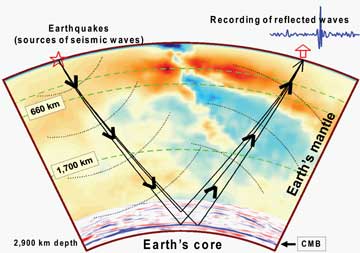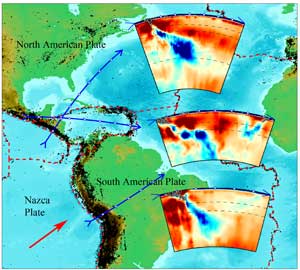|
FEATURE
Boldly Going Deeper Into Earth
Robert van der Hilst
 AGI/Meteor Studios |
| Artist’s rendering of Earth’s interior, showing the inner and outer core, lower and upper mantle, and crust. |
We are ever learning more about the worlds far above Earth, but the rocky world below us remains largely mysterious. Yet Earth’s dynamic interior holds keys to understanding the planet’s early state and how its biology, hydrology and atmosphere evolved and shaped the planet on which we now live. Processes deep within Earth are also directly related to such societal issues as seismic and volcanic hazards and the formation of natural resources.
Much of the mystery remains because direct sampling of Earth’s deep interior is currently, and perhaps indefinitely, impossible, due to the extreme pressures and temperatures, which reach millions of atmospheres and several thousand Kelvin, respectively. Human-made probes can barely descend to about 10 kilometers (6 miles) deep, and volcanism rarely brings up samples from deeper than 150 kilometers (93 miles).
Such tiny distances are dwarfed by Earth’s actual dimensions, leaving us only with indirect methods if we want to “see” any deeper into the planet’s interior. But such methods also have caveats: While electromagnetic waves propagate easily through outer space and can thus be used for imaging planetary surfaces, seismic waves, which are used to probe Earth’s interior, must propagate through media that are complex and not very well known, before they are finally measured at Earth’s surface. That complicates the picture.
Knowledge of the deeper realms, therefore, is pieced together from a range of surface observations, meteorite and solar atmosphere analyses, experimental and theoretical mineral physics and rock mechanics, and computer simulations. Earth’s onion-like inner structure, composed of several “shells,” has been known for half a century: The crust is 5 to 70 kilometers (about 3 to 43 miles) deep, the mantle extends from the base of the crust to about 2,890 kilometers (1,796 miles) deep, and the core extends from 2,890 to 6,371 kilometers (1,796 to 3,959 miles) deep. Additionally, a so-called discontinuity at 660 kilometers (410 miles) deep separates the mantle into upper and lower parts.
Over the past decade, several discoveries have revealed that Earth’s interior is far more interesting and enigmatic than the simple shells-with-near-constant-properties depicted in the classical models. As we look more closely and in greater detail at the crust and mantle, we are discovering that the interior layers of Earth are heterogeneous at all scales. There is much we do not know about the structure, and the chemical and mineralogical composition, of Earth’s mantle.
Mantle mysteries
Characterizing the heterogeneity within and the interaction between the layers of Earth will remain a frontier of science for decades to come. To better understand Earth’s interior, researchers have many issues to address: to map in higher resolution the trajectories of convective flow, to establish the variability of chemical composition within a layer, to quantify the spatial scales of variability in the mantle and to understand the nature and behavior of the boundary layers of convection in the mantle and core.
One primary but as-yet-unresolved issue concerns the nature of mantle convection, the slow stirring that helps cool the planet by transferring radiogenic and primordial heat from Earth’s interior to its surface. Evidence that the mantle’s upper and lower layers are different in composition, and that therefore they might be convecting independently, has long competed with views that the entire mantle is essentially homogeneous.
Seismic tomography, a technique that uses seismic waves triggered by earthquakes or human-made explosions to image Earth’s structure, is deepening our understanding of this and other questions. Adapted in the late 1960s from medical computer-aided tomography, seismic tomography suggests that the 660-kilometer- (410-mile-) deep mantle discontinuity, which is associated with changes in mineral phases, does not always block convective flow in the mantle. Seismic tomography data suggest that in some locations, slabs of subducted lithosphere have sunk to the core-mantle boundary.
In 2006, this technique may have solved a long-standing geologic puzzle. About 50 million years ago, the Indian Plate — which had broken off from Australia and Antarctica some 75 million years earlier and headed northward — rammed into Eurasia at the relatively speedy rate of 15 centimeters (6 inches) per year. The force of the two continents colliding crumpled the crust and initiated the formation of the Himalayas (see story, this issue). Today, the mountains continue to grow, as the Indian Plate continues to push northward into Eurasia.
But therein lies the mystery. Most of the Indian Plate’s crust was pushed under Eurasia, helping to lift the Tibetan Plateau and push the mountains ever higher. Yet, geophysicists estimate that given our knowledge about the Tibetan Plateau and the tectonics that formed it, about 2,400 kilometers (1,500 miles) of the crust disappearing under Eurasia is unaccounted for.
 Rob van der Hilst/MIT |
| Earthquakes produce seismic waves that travel through Earth’s mantle and reflect off the core-mantle boundary, illuminating the structure of Earth from crust to core, as shown here. This high-resolution imaging method, which uses data from tens of thousands of seismograms, was adapted from oil and gas exploration. |
Limited availability of data has long complicated tomographic imaging of the region beneath the Tibetan Plateau, but new analyses, with data from new seismograph arrays, may have located the “missing” crust, at last. Using the relative temperatures of the Indian (cold) and Eurasian (hot) plates as markers, these exciting new images of the crust and mantle underlying this region show that the Indian Plate may have moved northward so rapidly that its leading, subducted edge is folding back on itself, pushing deeper into the mantle — a process scientists would not have been able to confirm without this sophisticated imaging (see Geotimes, April 2007).
In most regions, however, the complex subduction processes and associated seismic and volcanic activity are only partially understood. Even more uncertainty remains about upwellings, or mantle plumes, because seismic analysis has still not been able to narrow in on their nature and size. That large anomalous structures exist in the deep mantle — for instance, beneath Africa — is no longer controversial. But the nature, whereabouts and role of these thermal plumes remain topics of heated debate. To further complicate the picture, different types of seismic waves originating from an earthquake behave differently — a smoking gun for variability in the structure and composition of the mantle. Still, how widespread the variability is, and how changes in minerals, chemistry or temperature contribute to these variations in seismic wave speed, are not well-known.
To investigate how minerals alter in response to stresses due to changes in temperature, pressure and composition with laboratory experiments and supercomputer calculations, mineral physicists are beginning to slowly unravel the mineralogy and phase chemistry of the deep mantle. In 2004, for example, researchers discovered that the mineral magnesium-perovskite, which dominates the lower mantle, can change in form to post-perovskite at depths between 2,600 and 2,800 kilometers (1,616 and 1,740 miles). This discovery is shedding light on the enigmatic lowermost mantle structures (see Geotimes, June 2005). Still, much of the research focuses on relatively simple compositions, and high-pressure research is only possible on tiny minerals. With so much still unaccounted for, new discoveries are almost certainly looming on the horizon.
 Rob van der Hilst/MIT |
| Seismic tomographic images offer a window into the subduction of oceanic plates beneath Central and South America. In these slices of Earth’s interior, the blue zones depict fragments of ancient plates as they sink from the surface into the deep mantle, sometimes all the way to the core-mantle boundary. Earthquakes (small white dots) occur only in the top 300 kilometers. |
Core questions
Like the mantle, the core holds its own questions. Rather than the thick, slowly churning silicates of the mantle, the outer core consists of liquid metals, primarily an alloy of iron and nickel. But the outer core also appears to be slightly less dense than this alloy would require, suggesting that lighter elements must be present. Scientists are also pondering the possibility that the core hosts radiogenic, heat-producing elements such as potassium.
The core is usually considered homogeneous, but a subtle variability cannot be ruled out, especially near the boundaries that separate the outer core from the mantle above and the inner core below. Establishing or refuting the existence of such structures with seismic waves is tricky because the waves travel through a mixed, heterogeneous mantle before they are observed and analyzed. With modern datasets and new analysis techniques, however, such investigations are becoming possible.
The core is also the source of Earth’s magnetic field (see story, this issue), but full understanding of the generation and long-term change of this field requires better knowledge about fluid flow and the energy balances in the core than is available now. A prime target of cross-disciplinary research is the double (thermo-chemical) boundary layer that separates the core from the mantle. To understand Earth’s thermal history, as well as the geodynamo, we must know how much heat is transported from the core into the mantle, how this heat flux varies from place to place, and how dynamical instabilities of these layers control convective flow above and below them.
Deeper toward the very center of our planet, extreme pressures increase the temperature needed to melt the iron-nickel alloy. As a consequence, the iron-nickel alloy becomes solid, forming the inner core (the mechanical properties of this remote body are not known, so some local partial melt cannot yet be ruled out). Tiny in volume, the inner core still plays an important role in stabilizing Earth’s magnetic field against pole reversals, and the structure and evolution of the inner core put important constraints on the cooling history of the whole planet. For these reasons, the inner core has been a subject of intense study, and over the past decade many exciting discoveries have been made about its rate of rotation relative to the rest of Earth, about what controls the orientation of its iron-nickel crystals, and whether the inner core itself has its own layers. It is likely that continued integration of seismological and mineral physics datasets and constraints from studies of the geomagnetic field will lead to new understanding of the conditions at the center of the planet.
Combining forces
Although the answers to many of the above questions have long been out of reach, several recent developments in the fields of seismology, mineral physics and computational geophysics are dramatically enhancing our capabilities for new discovery and new understanding.
Some of these developments go hand in hand. Modern seismic projects such as the USArray component of EarthScope (and similar efforts worldwide, for instance in China) — which involve large numbers of high-quality seismometers — have begun to produce massive amounts of three-component, broadband data that sample Earth’s interior as never before. Meanwhile, modern cluster and grid computing is enabling the use of new mathematical and statistical concepts and of massive brute-force data manipulations to generate increasingly powerful methods for seismic imaging and uncertainty estimation.
As a result of this synergy, increasingly larger parts of the recorded seismic data can be used for imaging. Indeed, in traditional methods, only a tiny fraction of the recorded data was used: for instance, the travel time of a specific seismic wave. Not only does new theory and high-performance computing allow development of full wave techniques, seismologists have also begun to realize that what used to be discarded as mere noise can actually be used as a signal. “Full wave” and “interferometry” techniques are both still in their infancy, but they are likely to revolutionize our ability to image Earth’s deep structure over the next decade. For maximum impact, for deep Earth imaging and for seismic monitoring, hazard assessment and effective early warning, carefully crafted protocols for data exchange and scientific collaboration should allow the sharing and joint use of data from seismograph networks all over the world.
As the infrastructures for high-performance supercomputing continue to improve, it is also becoming possible to model dynamic processes on a wide range of length and timescales and to calculate stable mineral and phase assemblages over a wide range of temperatures, pressures and chemical compositions. Indeed, using new laboratory experiments and more daring calculations, mineral physicists are exploring the behavior of geological materials of increasing structural and chemical complexity and under extreme physical conditions. We use insight from this research to interpret the seismological images in terms of variations in temperature and chemical composition. And while modern seismograph networks are providing high-resolution “telescopes” for deep Earth research, networks of satellites hovering far above the surface are providing ever-increasing capabilities for observing minute changes in Earth’s surface, gravity and magnetic fields due to spatial (and temporal) changes in deep structure (see story, this issue).
Similar to what Incorporated Research Institutions for Seismology has done for seismology, the Consortium for Materials Properties Research in Earth Sciences (both supported by the National Science Foundation) and the Computational Infrastructure for Geodynamics (CIG) are helping to foster collaboration and engage young scientists in cutting-edge research by maintaining community facilities and complex (open source) computer codes. In combination, these developments allow scientists to integrate data from geophysical imaging, mineral physics and geochemistry into self-consistent models of how our planet has evolved over time, how it behaves today, and, perhaps, how it will develop in the future.
Links:
"Riding the Wilson Cycle," Geotimes, July 2007
"Found: Tibet's missing anchor," Geotimes, April 2007
"Double-crossing the core," Geotimes, June 2005
"X-ray Eyes in the Sky," Geotimes, July 2007

 Subscribe
Subscribe


